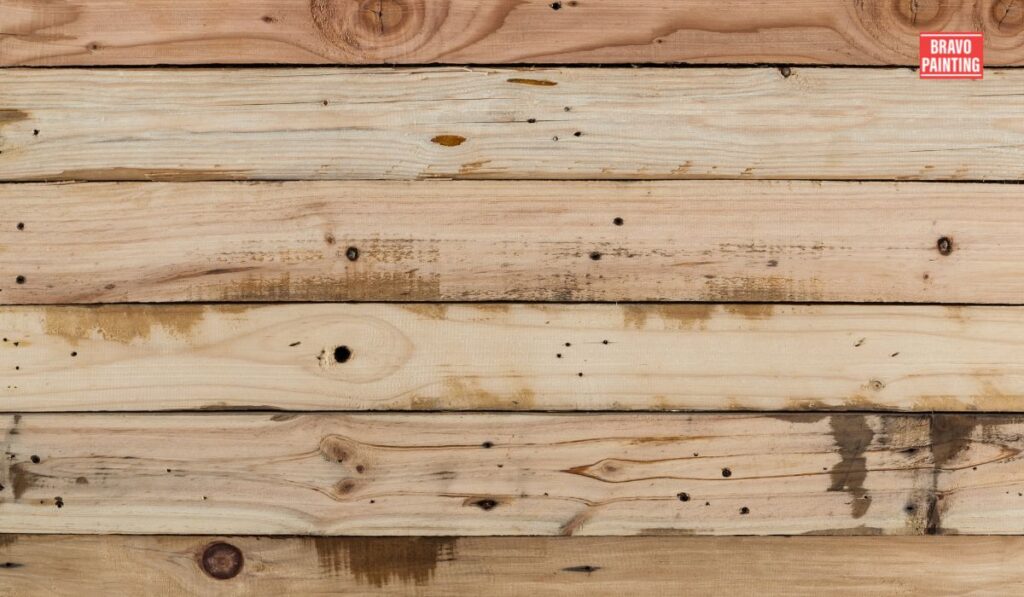Staining wood surfaces can enhance the natural beauty of the wood, protect it from damage, and extend its lifespan.
For commercial projects, proper preparation of the wood surface is crucial to ensure an even, professional finish.
Below are the detailed steps to prepare commercial wood surfaces for staining.
Assessing the Wood Surface
Identify Wood Type: Different wood types absorb stains differently. Softwoods like pine absorb more stain and often appear darker, while hardwoods like oak may require pre-treatment to achieve the desired finish.
Condition of the Wood: Check for any defects such as cracks, knots, or warping. Address these issues before proceeding with staining.
Gathering Necessary Materials
Safety Gear: Gloves, safety goggles, and a dust mask are essential to protect yourself from dust and chemicals.
Tools and Supplies: Sandpaper (various grits), sanding block or power sander, tack cloths, wood conditioner, stain, brushes, rags, painter’s tape, and drop cloths.
Cleaning the Surface

Remove Old Finish: If the wood has an existing finish, strip it using a chemical stripper or by sanding. Follow the manufacturer’s instructions for chemical strippers and ensure proper ventilation.
Clean the Wood:
- Use a vacuum or brush to remove dust and debris.
- Wipe the surface with a damp cloth to remove any remaining dirt.
- Allow the wood to dry completely before proceeding.
Sanding the Wood
Initial Sanding: Start with a coarse-grit sandpaper (80-100 grit) to smooth out rough surfaces and remove any residual finish. Always sand in the direction of the wood grain to avoid scratches.
Progressive Sanding: Move to finer grits (120, 150, and finally 220) for a smoother finish. The final sanding should make the wood feel silky to the touch.
Check for Smoothness: Run your hand over the surface to ensure there are no rough spots or splinters—re-sand areas as necessary.
Dealing with Wood Grain and Pores
Open-Grain Woods: For woods like oak and ash, which have open pores, consider using a grain filler to achieve a smooth finish.
Apply the filler with a putty knife, allow it to dry, and sand the surface smooth.
Conditioning the Wood: Apply a pre-stain wood conditioner to help the wood absorb the stain evenly. This step is crucial for softwoods and some hardwoods that tend to smudge.
Follow the manufacturer’s instructions regarding drying time.
Applying the Stain
Choosing the Right Stain: Select a stain type and color suitable for your project.
Oil-based stains penetrate profoundly and provide durable protection, while water-based stains dry faster and have less odor.
Test the Stain: Always test the stain on a scrap piece of the same wood or in an inconspicuous area to ensure the desired color and finish.
Staining Process:
- Stir the stain thoroughly before application to ensure an even color.
- Apply the stain with a brush, sponge, or rag, working in manageable sections.
- Apply the stain in the direction of the wood grain for uniform coverage.
- Allow the stain to penetrate for 5-15 minutes, depending on the desired darkness, then wipe off excess with a clean cloth.
Even Application: Ensure an even application by blending overlapping sections well to avoid lap marks.
For a deeper color, apply additional coats following the same process, allowing proper drying time between coats.
Finishing Touches
Drying Time: Allow the stain to dry completely as per the manufacturer’s instructions, which can range from a few hours to overnight.
Seal the Surface: Once the stain is dry, apply a protective finish such as polyurethane, varnish, or lacquer. This will protect the wood from moisture, wear, and tear.
Apply the finish in thin, even coats, sanding lightly between coats with fine-grit sandpaper (320 grit) for a smooth result.
Final Inspection: Inspect the wood surface for any missed spots, uneven areas, or imperfections.
Touch up as necessary and allow the finish to cure completely before handling or installing the wood.
Maintaining the Stained Wood
Regular Cleaning: Keep the stained wood clean by dusting regularly with a soft, dry cloth.
For deeper cleaning, use a damp cloth followed by drying with a clean towel.
Periodic Reapplication: Depending on the wear and tear, the protective finish may need to be reapplied every few years.
Lightly sand the surface and apply a fresh coat of finish to maintain its appearance and durability.
Avoid Excessive Moisture: Protect the wood from prolonged exposure to moisture, which can damage the stain and the wood itself.
Use coasters, placemats, and protective pads to prevent water rings and scratches.
Use Wood-Safe Cleaners: When necessary, use cleaners specifically designed for wood surfaces to avoid stripping the stain or damaging the protective finish.

Special Considerations for Commercial Spaces
High-Traffic Areas: For commercial wood surfaces in high-traffic areas, consider using more durable stains and finishes.
Polyurethane is a good choice for floors and surfaces that will endure heavy use.
UV Protection: If the wood surfaces are exposed to direct sunlight, use a finish that includes UV protection to prevent fading and discoloration over time.
Fire-Retardant Treatments: In some commercial settings, it might be necessary to use fire-retardant stains or finishes.
These products can provide additional safety and compliance with local fire codes.
Environmental Considerations: Choose low-VOC or water-based stains and finishes to reduce indoor air pollution and comply with environmental regulations.
Conclusion
Proper preparation of commercial wood surfaces for staining is a meticulous process that ensures a beautiful, durable finish.
By following these steps—cleaning, sanding, conditioning, staining, and sealing—you can achieve professional results that enhance the natural beauty and longevity of the wood.
Remember, patience and attention to detail are critical to a successful staining project.
With the right approach, your stained wood surfaces will not only look stunning but will also withstand the test of time in commercial environments.
For more information or professional assistance with your commercial wood staining projects, visit Bravo Painting Company.
FAQs
Why is it essential to identify the wood type before staining?
Identifying the wood type is crucial because different woods absorb stains differently. Softwoods like pine absorb more stain and appear darker, while hardwoods like oak may need pre-treatment to achieve the desired finish.
What should I check for when assessing the condition of the wood?
Check for any defects such as cracks, knots, or warping. Address these issues before proceeding with staining to ensure a smooth and professional finish.
What safety gear is necessary when preparing wood surfaces for staining?
Wear gloves, safety goggles, and a dust mask to protect yourself from dust and chemicals.
What tools and supplies do I need for preparing wood surfaces?
You’ll need sandpaper (various grits), a sanding block or power sander, tack cloths, wood conditioner, stain, brushes, rags, painter’s tape, and drop cloths.
How do I remove an existing finish from the wood surface?
Use a chemical stripper or sand the surface. Follow the manufacturer’s instructions for chemical strippers and ensure proper ventilation.
What is the proper method for cleaning the wood surface before staining?
Use a vacuum or brush to remove dust and debris, then wipe the surface with a damp cloth. Allow the wood to dry completely before proceeding.
How should I sand the wood surface?
Start with coarse-grit sandpaper (80-100 grit) to smooth rough surfaces and remove residual finishes. Progress to finer grits (120, 150, and finally 220) for a smoother finish. Always sand in the direction of the wood grain.
What should I do if I encounter rough spots or splinters after sanding?
Run your hand over the surface to check for smoothness. Re-sand any rough spots or splinters as necessary.
How do I handle open-grain woods like oak or ash?
Consider using a grain filler to achieve a smooth finish. Apply the filler with a putty knife, allow it to dry, and sand the surface smooth.
Why is it essential to use a wood conditioner before staining?
A wood conditioner helps the wood absorb the stain evenly, which is especially important for softwoods and some hardwoods that tend to smudge.
How do I choose the right stain for my project?
Select a stain type and color suitable for your project. Oil-based stains penetrate profoundly and provide durable protection, while water-based stains dry faster and have less odor.
How can I ensure the stain color and finish are as desired?
Test the stain on a scrap piece of the same wood or in an inconspicuous area to ensure the color and finish meet your expectations.
What is the proper staining process?
Stir the stain thoroughly before application. Apply it with a brush, sponge, or rag, working in manageable sections and the direction of the wood grain. Allow the stain to penetrate for 5-15 minutes, then wipe off excess with a clean cloth.
How can I ensure an even application of stain?
Blend overlapping sections well to avoid lap marks. For a deeper color, apply additional coats following the same process, allowing proper drying time between coats.
How long should I allow the stain to dry?
Follow the manufacturer’s instructions for drying time, which can range from a few hours to overnight.
Blog, Staining

